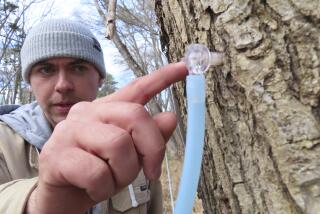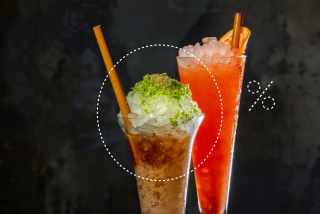It’s hop harvest time. What does that mean for your beer?
Brewers from across the country are convening in Washington state’s Yakima Valley for the hop harvest, and what they find among the bails and heaped lots of the aromatic ingredient has a big impact on what’s in your beer glass in the coming months -- and maybe for years to come.
Hops -- a flower-like catkin that grows on long twisting vines, also known as bines -- are an integral ingredient in nearly every style of beer. They provide the balancing bitterness and are an important natural preservative and antiseptic that prevents a brew from souring. Hops are also an increasingly important flavor in popular beer styles, and the growing popularity of hop-driven brews such as IPAs has created a dynamic market for the most interesting and vibrant hop varietals.
The hop plant prefers to grow in a narrow band of longitudes with just the right length of length and just the right combination of temperate climate -- and the Yakima Valley is America’s hop yard capital.
Around three-quarters of all the hops grown in the nation are grown in that valley. When it’s harvest time, the bines are cut from their towering trestles and fed into rotating drums that remove the oil-rich cones from the bines. These whole cones are then kilned to dry and preserve the hops before being either pressed into bales or further processed into pellets that resemble rabbit food.
Your Los Angeles Craft Beer Guide
During the late summer harvest, the hop farms, co-ops and brokers host brewers for hop selection -- a mercantile tradition in which brewers evaluate the crop and nose out which of the different varieties and lots they want to use in the next year’s brewing.
The most popular varieties -- with names such as Citra, Simcoe and Mosaic, synonymous with pungent IPAs -- are often contracted years in advance, and finding lots for sale is always a challenge for new or small breweries. New experimental hop varieties offer flavor and aroma possibilities to the intrepid brewer, and these hybrids and crossbreeds may hold the future flavors of craft beer.
Golden Road Brewing’s brewmaster, Jesse Houck, recently returned from a selection trip in Yakima and said this year’s crop of popular varieties, such as Centennial and Simcoe, looks pretty good, and that he made sure to spend extra time in the “baby plots” where the farmers experiment with new cultivars.
“It’s just one or two vines of each [variety], and [the farmers] are trying to pick which is the next hop that they will move forward with in larger scale production,” Houck said. “Usually the larger breweries provide notes about what they’re interested in and what they want to see in production. There are some really cool ones.”
Houck described a unique aroma from one of these new hop varieties that he’s particularly excited about: “I don’t want to give the name out -- I want to try and grab some for next year, but it has a really great vanilla, coconut character. It was great, I want to do so many different things with that hop.”
Besides the excitement of new flavors and aromas provided by the experimental breeding programs at the hop farms, the most obvious impact that hop harvest has for the average craft beer fan is that it means the availability of fresh hop beers.
Also known as “wet hopped” beers, these are made with a small fraction of the harvest that doesn’t get kilned or dried. These hops only have a shelf life of a few days instead of the months that the more processed crop enjoys.
Brewers, especially in the Pacific Northwest, treasure the ephemeral fresh hops and organize special shipments and schedule specific brew days during the short window that they’re available. The results are hoppy brews that showcase a dense and complex aroma with a grassy and resinous character. An aroma-driven IPA made with wet hops feels like someone cranked up the volume and kicked in a bass-thumping subwoofer.
The hop-slingin’ brewers at El Segundo Brewing Co. are planning three different wet-hopped beers with this year’s crop, including a bottled batch of their superlative Mayberry IPA featuring a sticky charge of fresh Mosaic hops. It should be a can’t-miss beer for L.A.’s hop lovers, and El Segundo Brewing is planning a “Bine to Bottle” event to promote the wet hopped brews.
More widely available are the Wet Hop Harvest special release from Sierra Nevada Brewing Co. (which should be available soon), Great Divide Brewing’s Fresh Hop pale ale and Chasin’ Freshies and Hop Trip, both from Deschutes Brewing in Oregon.
More brews that demonstrate the fresh hop flavor are being announced as more of the hop harvest comes in, and perhaps sometime next year the aromatic pale ale that Houck imagines will get brewed at Golden Road to showcase the coconut and oak-like vanilla aromas of the new hop variety he discovered in Yakima.
ALSO
The McRib is back! But how do you find it?
5 great fish tacos in L.A., and why you need to drive to La Puente
Revolutionario takes fusion to the extreme with pozole tagine and falafel tacos
More to Read
Eat your way across L.A.
Get our weekly Tasting Notes newsletter for reviews, news and more.
You may occasionally receive promotional content from the Los Angeles Times.






